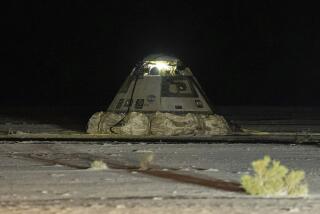Last moments aboard the Columbia
Poor design of their pressure suits led the seven astronauts aboard the Columbia space shuttle to black out almost immediately as the craft started breaking apart during reentry in 2003, and they were probably killed by the violent contortions, a NASA panel said Tuesday.
Other design flaws with seat belts, helmets and parachutes also could have caused their deaths if they had survived the depressurization and intense buffeting, the panel said in its final report on the incident.
Fixing the deficiencies would not have saved the astronauts because the accident -- occurring at high altitude and hypersonic speed -- was “unsurvivable,” the report said. But such corrections could improve chances of survival in less serious accidents.
Even though parts of the report were redacted to protect the astronauts’ families, it represents the most graphic and harrowing account of the crew’s final moments.
NASA officials already knew the astronauts had died from either a lack of oxygen or from striking objects in the cabin, and the report was unable to distinguish between the two possibilities. But it does catalog all the things known to have gone wrong and provide new details about the crash.
One comforting conclusion in the 400-page report is that, after the first few seconds, the astronauts were probably unconscious and never knew what was happening.
“On behalf of their colleagues and families, I can say that we are relieved that we discovered this,” astronaut Pamela Melroy, deputy project manager for the investigative team, said at a news conference.
The mission was doomed when a piece of foam broke off the external fuel tank during launch on Jan. 16, 2003, and damaged the leading edge of Columbia’s wing. The wing was not inspected because the prevailing belief was that foam could not cause significant damage.
On its reentry to Earth’s atmosphere on Feb. 1, Columbia broke up over Texas, killing all seven astronauts.
A 2003 report angrily blamed the accident on a “broken safety culture” at NASA.
The new report said the first problem crew members encountered was their pressure suits, which were not part of the shuttle’s original equipment. They were added after the 1986 Challenger disaster.
Because of design problems with the suits, crew members could not keep the visors of their helmets down throughout reentry because it led to high oxygen concentrations in the cabin. And wearing the suit’s gloves made it difficult or impossible to perform many tasks.
At the time of the accident, three crew members were not wearing gloves, one did not have his helmet on, and none had the visors down.
The report said the crew members immediately lost consciousness from depressurization.
But “the crew was doing everything they had been trained to do and were doing everything right,” Melroy said.
NASA has since made astronauts seal their pressure suits earlier in the reentry, she said.
As the cabin began its wild gyrations during descent, the astronauts were protected only by lap belts. The upper-body belts did not hold them in place because the inertial locks, such as those on car seat belts, were not designed for such sideways motion. The astronauts were thrown around violently.
The contortions were exacerbated by the helmets on the pressure suits, which did not conform to the astronauts’ heads and offered no protection from impacts.
The breakup of the cabin exposed the crew to heat and abrupt deceleration caused by friction from the atmosphere. The report said “all crew were deceased before, or by the end of,” the breakup.
There is no protection in such an event “except to prevent its occurrence,” the report said.
Exposure to the near vacuum and the extreme cold of high altitude were also potentially lethal, the report said. The pressure suits were designed for a maximum altitude of 100,000 feet and a peak velocity of 645 mph -- well below the actual conditions.
Additionally, the astronauts wore parachutes, but they had to be deployed manually, which couldn’t be done because the crew was unconscious.
The report said future spacecraft would probably have sturdier bodies that were less likely to break apart. They would also have better restraints. New suits and helmets are being designed.
--
More to Read
Sign up for Essential California
The most important California stories and recommendations in your inbox every morning.
You may occasionally receive promotional content from the Los Angeles Times.










